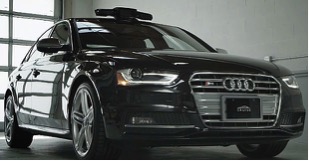WILL CRUISE AUTOMATION LET YOU UPGRADE YOUR DUMB CAR TO SUPER SMART STATUS?

Picture source: Cruise Automation
Big companies have to pick their fights carefully if they want to retain the most profitable parts of their business. IBM showed how not to do this back in the 1980s, when it kept the PC hardware and let Bill Gates take control of the software.
The big auto companies understand the danger of being, as they say, disinter-mediated. So, every time a technology emerges from the lab they decide whether to keep it close or cast it to their far-flung suppliers. Self-driving technology is the hot feature now, and most car makers are choosing to outsource just the sensors, such as radar, cameras, and GPS. Meanwhile they're building a shield of patents around in-house autonomous driving systems. But if those systems can themselves be reduced to a commodity, then aftermarket suppliers may grab the business and squeeze profit margins to nothing.
That's the threat posed by Cruise Automation, a San Francisco startup that said this week that it was taking early orders for a driver-assistance system it would install early next year on two late-model Audis. In highway driving, the cars would be able to keep to their lanes and avoid colliding with the car in front of them. The company says that the system, including installation, will cost US $10,000, and that it hopes to apply it one day to a wider range of cars.
That price may seem high, but consider that it would give existing models much of the smarts of the one-off prototype Audi showed at the Consumer Electronics Show in January. Also note that the single most self-controlled model on the market, the Mercedes S class, costs well over $90K.
"It is the best now, but I wouldn't have a business if I had that system," says Kyle Vogt, the founder of Cruise Automation. "With the Mercedes you have to have your hands on the wheel, and also, the way it steers is by braking the front-left or -right tire, so it can't handle sharper curves. It won't be able to keep you in the lane in that case; it's not designed for long-distance driving. Ours can go all the way to 80 miles per hour, hands free."
To get production volume up his company will have to adapt the system to a lot of different cars, "no easy task," he admits. "We've designed it to be modular, so it's not overly vehicle-specific. For instance, it's not integrated into the Audi's electronics."
The other task is to validate the system on more highways, first in California and later in other states. Hundreds of driver-hours are needed to gather and analyse the data for that, Vogt says. "If a road's not calibrated, then the system won't let you use it."
Like most driver-assistance systems in development at the big auto companies, the Cruise Automation package uses off-the-shelf sensors, including GPS, stereo cameras fixed to the inside of the windshield, and a radar module on the roof. Another, cheaper aftermarket system that reportedly relies purely on optical cameras is being developed by the Israeli startup Mobileye. By renouncing the radar, that system would be less useful in bad weather conditions.
"I think you could go very far with a camera-only solution," Vogt says. "The real question is whether it uses lidar," a laser-based optical equivalent to radar but having much better resolution. "Right now, it's hard to do long-range, low-cost, low-power lidar."
Vogt emphasises that he retains the ultimate backup system: the human behind the wheel. That's why he, along with most researchers outside Google, talk not of robots but of "advanced driver assistance systems," or ADAS.
Pretty good car automation is surprisingly easy; perfect automation is far tougher.
Article source by By Philip E. Ross in IEEE Spectrum
http://goo.gl/CpxjlY
http://spectrum.ieee.org/cars-that-think/transportation/self-driving/cruise-automation-upgrade-your-car
